


xxxxxThe Swiss mathematician and physicist Daniel Bernoulli was professor of medicine at the Academy of Sciences in St. Petersburg for eight years, and it was here that he worked with his fellow countryman Leonhard Euler. In 1733 he returned to Basel University to take the chair of anatomy and botany. As a mathematician he made notable advances in both trigonometry and differential equations, and his Exercitationes quaedam Mathematicae was well received. His major achievement, however, was in the field of hydrodynamics. In his Hydrodynamica (1738) he made a study of the pressure and velocity of fluids and produced the Bernoulli principle. This stated that the pressure of a moving liquid or gas decreases the faster it flows -
DANIEL BERNOULLI 1700 -
Acknowledgements
Bernoulli: detail, by the German artist Johann Niklaus Grooth (1723-
G2-
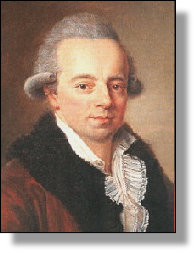 xxxxxThe brilliant Swiss mathematician and physicist Daniel Bernoulli was born in Groningen in the Netherlands, the son of Johann Bernoulli and the nephew of Jacques Bernoulli, both outstanding mathematicians of their day. After studying philosophy and medicine at the universities of Heidelberg, Strasbourg and Basel, he was appointed professor of mathematics at the Russian Academy of Sciences in St. Petersburg at the age of twenty-
xxxxxThe brilliant Swiss mathematician and physicist Daniel Bernoulli was born in Groningen in the Netherlands, the son of Johann Bernoulli and the nephew of Jacques Bernoulli, both outstanding mathematicians of their day. After studying philosophy and medicine at the universities of Heidelberg, Strasbourg and Basel, he was appointed professor of mathematics at the Russian Academy of Sciences in St. Petersburg at the age of twenty-
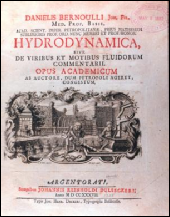 xxxxxThroughout a long career he made notable advances in the study of trigonometry and differential equations. In 1724, for example, he produced his Exercitationes quaedam Mathematicae -
xxxxxThroughout a long career he made notable advances in the study of trigonometry and differential equations. In 1724, for example, he produced his Exercitationes quaedam Mathematicae -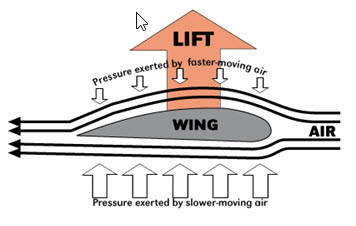 gases, attempting a mathematical explanation of their behaviour based on the assumption that gases were made up of a vast number of particles or molecules.
gases, attempting a mathematical explanation of their behaviour based on the assumption that gases were made up of a vast number of particles or molecules.
xxxxxA highly inquisitive man who was ever striving to broaden and popularise scientific knowledge, he also produced papers on a wide variety of other subjects, including astronomy, magnetism, marine technology and oceanography. For such work he won no less than ten prizes from the Paris Academy of Sciences.
xxxxxThe Swiss mathematician Leonhard Euler (1707-
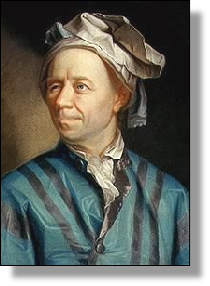 xxxxxThe Swiss mathematician Leonhard Euler (1707-
xxxxxThe Swiss mathematician Leonhard Euler (1707-
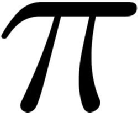 xxxxxDuring his first stay in St. Petersburg in the 1720s he began to lose his sight, and towards the end of his life he was almost totally blind. This obviously slowed down his work rate, but despite this disability, he wrote several major works and, in addition, produced hundreds of mathematical and scientific papers. These books and papers introduced many new concepts and a variety of techniques with which to solve problems. He was responsible, for example, for the introduction of many current notations, such as the method of naming the sides and angles of a triangle, and the use of the symbol pi for working out the circumference of a circle.
xxxxxDuring his first stay in St. Petersburg in the 1720s he began to lose his sight, and towards the end of his life he was almost totally blind. This obviously slowed down his work rate, but despite this disability, he wrote several major works and, in addition, produced hundreds of mathematical and scientific papers. These books and papers introduced many new concepts and a variety of techniques with which to solve problems. He was responsible, for example, for the introduction of many current notations, such as the method of naming the sides and angles of a triangle, and the use of the symbol pi for working out the circumference of a circle.
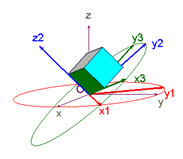 xxxxxHis Introduction to the Analysis of Infinities, published in 1748, together with other works, marks him out as one of the greatest mathematicians of the 18th century. In it, Euler not only gave a masterly summary of known data, but he also gave the first strictly analytical treatment of algebra, the theory of equations, trigonometry and analytical geometry. Nor were other branches neglected. In the theory of numbers it is to Euler that we owe the discovery, in 1783, of the law of quadratic reciprocity, a vital part of the modern theory. Furthermore, his Institution of Differential and Integral Calculus, produced in separate volumes, and his Introduction to Algebra, published in 1770, provided a comprehensive coverage of these subjects and, as such, proved first-
xxxxxHis Introduction to the Analysis of Infinities, published in 1748, together with other works, marks him out as one of the greatest mathematicians of the 18th century. In it, Euler not only gave a masterly summary of known data, but he also gave the first strictly analytical treatment of algebra, the theory of equations, trigonometry and analytical geometry. Nor were other branches neglected. In the theory of numbers it is to Euler that we owe the discovery, in 1783, of the law of quadratic reciprocity, a vital part of the modern theory. Furthermore, his Institution of Differential and Integral Calculus, produced in separate volumes, and his Introduction to Algebra, published in 1770, provided a comprehensive coverage of these subjects and, as such, proved first-
xxxxxBut, like Bernoulli, Euler's interests were not confined to one scientific discipline. He also put his mind to a variety of subjects, including astronomy, mechanics, optics and acoustics. The basic principles of a number of these subjects were contained in his Lettres à une princess d'Allemagne, begun in 1768 and written over four years. In astronomy, he attempted to make a more precise calculation of the moon's movements, and he made some headway despite the problems associated with the interactions of moon, sun and earth. This led to work on the fluctuation of tides and an interest in fluid mechanics, Bernoulli's particular line of research, but to which Euler contributed.
Including:
Leonard xxxxxxx Euler



